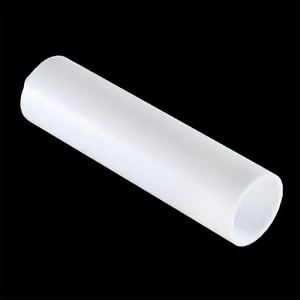In the world of plumbing, selecting the right materials that ensure both durability and superior performance is of utmost importance. Among the myriad of materials available, PTFE tubing has emerged as a prominent choice, particularly due to its exceptional chemical resistance and versatility across various industrial applications. This comprehensive guide will navigate you through the essential aspects of PTFE tubing, emphasizing its critical role and advantages in plumbing.
PTFE, or Polytetrafluoroethylene, is a synthetic fluoropolymer distinguished by its remarkable chemical resistance, exceptional thermal stability, and low coefficient of friction. These intrinsic properties render PTFE tubing a high-performance material ideally suited for plumbing applications, where durability and reliability are paramount. Its unique characteristics make it stand out among other materials, often becoming the go-to solution for challenging environments.
- Chemical Resistance: PTFE’s outstanding resistance to most chemicals makes it an ideal choice for transporting aggressive substances without the risk of degradation. This characteristic ensures that the tubing maintains its integrity even in the harshest chemical environments, providing a reliable conduit for a wide range of substances.
- Thermal Stability: Capable of withstanding an extensive temperature range from -328°F to 500°F (-200°C to 260°C), PTFE tubing maintains its properties without compromise. Its ability to perform in both extreme cold and heat makes it indispensable for applications where temperature fluctuations are frequent.
- Low Friction: The smooth surface of PTFE tubing significantly reduces friction, which is essential for maintaining consistent flow rates. This property not only enhances the efficiency of fluid transport but also minimizes wear and tear, prolonging the tubing’s lifespan.
- Non-stick Surface: PTFE’s non-stick nature prevents clogging and build-up within the tubing, ensuring smooth operation over time. This feature is particularly beneficial in environments where residue build-up can impede functionality and require frequent maintenance.
PTFE tubing is not merely a high-performance option; in many cases, it’s a necessity in environments where standard materials may fall short. Its unique properties offer several advantages that make it a game-changer in the plumbing industry.
PTFE tubing’s robust resistance to wear and tear ensures long-lasting performance, significantly reducing the need for frequent replacements. This inherent durability translates into substantial cost savings over time, as the need for maintenance and replacements diminishes. Industries investing in PTFE tubing can expect reliable service life, minimizing operational interruptions and associated costs.
Whether it’s for transporting acids, solvents, or gases, PTFE tubing proves suitable across a wide spectrum of plumbing applications. Its versatility makes it a preferred choice in diverse industries, including chemical processing, food and beverage, pharmaceuticals, and more. In each of these sectors, the ability of PTFE tubing to handle different substances safely and effectively underscores its indispensable role.
PTFE is non-toxic and safe for use in environments that demand strict adherence to hygiene and safety standards. It complies with FDA regulations, making it suitable for applications within the food and beverage industries. This compliance ensures that PTFE tubing can be trusted in sensitive environments where safety cannot be compromised.
Plumbing with PTFE tubing requires careful consideration of both the application and the environment to ensure optimal performance. Here’s a detailed step-by-step guide for effective installation.
Begin by accurately measuring the length of PTFE tubing required for your project. Use a sharp tube cutter or a clean, sharp blade to achieve a precise cut. Ensuring the cut is straight is crucial to avoid any issues with fitting and sealing, which could compromise the system’s integrity.
Opt for fittings that are compatible with PTFE tubing, with compression fittings often recommended for their ability to create a secure, leak-proof seal. Choosing the right fittings is critical to maintaining the system’s reliability and preventing leaks.
Carefully insert the tubing into the fitting, ensuring it is fully seated. Follow the manufacturer’s instructions to tighten the fitting properly, achieving a secure connection without causing damage. Over-tightening should be avoided as it can compromise the tubing’s structural integrity.
After installation, conduct a thorough test for leaks by running water or the intended fluid through the tubing. Carefully inspect all connections and fittings to ensure there are no leaks, which could indicate an issue with the installation or material compatibility.
While PTFE tubing offers numerous advantages, comparing it with other types of industrial tubing is essential to determine the best fit for your specific application.
- Chemical Resistance: PTFE is superior in chemical resistance compared to PVC, which may degrade when exposed to certain chemicals. This superior resistance makes PTFE a more reliable choice for chemical-intensive environments.
- Temperature Range: PTFE can withstand higher temperatures than PVC, offering greater versatility in extreme conditions. Its ability to perform under such temperature variances makes it ideal for applications that demand robust thermal resilience.
- Weight: PTFE tubing is lighter than stainless steel, simplifying handling and installation. This lightweight nature can be advantageous in applications where ease of installation and flexibility are critical considerations.
- Corrosion Resistance: While both materials offer resistance to corrosion, PTFE provides better chemical resistance against a broader range of substances. This enhanced resistance ensures that PTFE can handle more aggressive environments without compromising performance.
Conclusion: The Future of PTFE Tubing in Plumbing
PTFE tubing’s unique properties make it an indispensable material in modern plumbing applications. Its ability to withstand harsh environments, coupled with its non-reactive nature, ensures that it remains a top choice for industries requiring reliable and durable solutions.
By understanding the benefits and proper installation techniques of PTFE tubing, you can optimize your plumbing systems for efficiency and longevity. As industries continue to evolve and demand higher performance from their materials, PTFE tubing’s role is set to expand, solidifying its place as a cornerstone in innovative plumbing solutions. The demand for such high-performance materials is only expected to grow, underscoring the importance of PTFE in future plumbing advancements.









